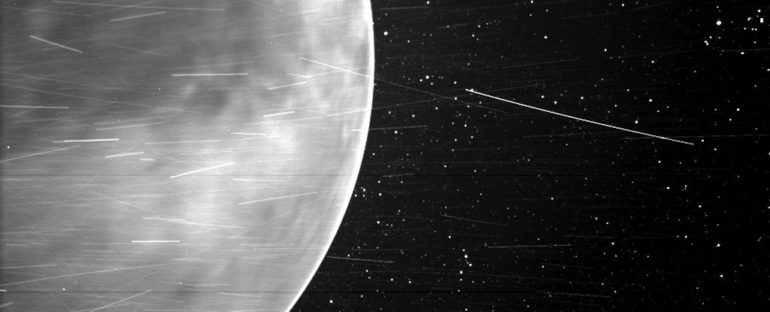Although its main mission is staring at the Sun, NASA’s Parker Solar Probe will take any opportunity to send data back home to Earth.
The planet Venus represents just such an opportunity, or rather, seven of them. Seven times during its mission, the probe will swing around Venus for a gravity assist, using the planet’s gravity as a slingshot for course and speed corrections as it edges closer and closer to the Sun.
The solar probe made the third of these maneuvers on 11 July 2020, and as it approached, it took a glamour shot of the planet’s night side using the Wide-field Imager for Parker Solar Probe (WISPR) instrument.
Parker isn’t the only probe to take pics of Venus as it wends its way through the inner Solar System. BepiColombo, a joint European and Japanese space agency Mercury probe, took a video of Venus as it made a gravity assist maneuver last year.
BepiColombo’s Venus flyby. (ESA/BepiColombo/MTM)
Those images show the planet as relatively smooth and featureless. That’s not at all surprising – Venus is shrouded by a thick, toxic atmosphere with clouds of mainly sulfuric acid that reflect about 70 percent of the light that hits them. That’s why Venus is one of the brightest objects in the night sky.
The Parker team expected to see a similarly featureless orb – but that’s not what they saw when they processed the WISPR data.
If you look at the image, you can see a bright glow around the rim of the planet. That, the team believes, is nightglow.
This is produced by atoms in the upper atmosphere. On the planet’s dayside, solar radiation splits upper atmosphere carbon dioxide into oxygen and carbon monoxide. When night falls, the atoms recombine into carbon dioxide, causing a glow.
This is something that also occurs on Earth, and Mars, and it’s been seen before on Venus; its presence in the Parker image is not surprising.
Nor are the white streaks – while the Parker team isn’t sure what they are, there are a number of candidates, including dust, cosmic rays, material ejected from the spacecraft after being hit by dust, or a combination of all of those.

What is surprising is that dark smear on the planet’s face. That’s a region called the Aphrodite Terra, the largest highland region on the surface of the planet.
WISPR, designed to image the solar corona and coronal ejections, is optimized for visible light observations – yet somehow it peered through Venus’ clouds.
The scientists think they know what happened, though. Venus currently has one active mission, the Japanese Space Agency’s Akatsuki probe. It sends back similar images, taken using its infrared camera, sensitive to temperature variations.
The Aphrodite Terra, with its higher altitude, is a lot cooler than the surrounding terrain, so in infrared or near-infrared images of the planet, it would be visible.
“WISPR effectively captured the thermal emission of the Venusian surface,” said astrophysicist and WISPR team member Brian Wood of the US Naval Research Laboratory. “It’s very similar to images acquired by the Akatsuki spacecraft at near-infrared wavelengths.”
This means WISPR could be more sensitive to infrared light than it was designed to be – which, in turn, opens up new possibilities for Parker’s main mission of studying the Sun. The Parker team is currently taking a closer look at the instrument’s specs to figure out what, exactly, it did.
“Either way,” said WISPR project scientist Angelos Vourlidas of Johns Hopkins Applied Physics Laboratory, “some exciting science opportunities await us.”



